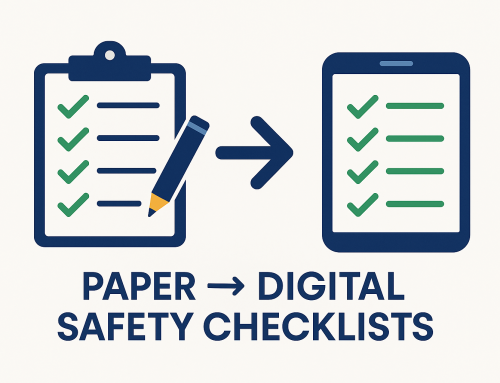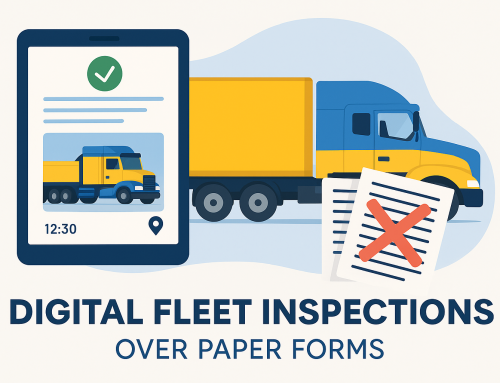Transformational Safety Culture: A Practical Playbook
A transformational safety culture swaps compliance-as-a-tick-box for leadership, learning, and visible accountability. In this guide, you’ll get a practical, step‑by‑step framework to build habits that improve worker engagement, reduce incidents, and strengthen your audit trail. We also show how digital checklists and an Action Register make safety actions provable — so improvements stick.
- Shift from rules-only to learning-led leadership and psychological safety.
- Make risk visible: capture photos, geo‑time stamps and assign actions.
- Close the loop fast with an auditable Action Register.
- Measure what matters: leading indicators, not just lagging metrics.
- Work online or offline — submit saved forms once connectivity returns.
Table of Contents
What is a Transformational Safety Culture?
A transformational safety culture is one where leaders and teams prioritise learning, transparency and proactive risk control over reactive rule‑enforcement. It’s shaped by behaviours: leaders model safe work, workers speak up, and issues are logged, tracked and closed with evidence. International frameworks such as ISO 45001 (OH&S management systems) emphasise continual improvement and engagement.
In Australia, credible guidance also comes from Safe Work Australia’s leadership and culture resources, which outline practical leadership principles for building a positive WHS culture.
Why Transformational Beats Compliance‑Only
Compliance is essential — but on its own it can be brittle. Transformational cultures are resilient because they embed learning, evidence and accountability into daily work.
| Traditional (Compliance‑Only) | Transformational Safety Culture |
|---|---|
| Paper/spreadsheet checklists; hard to prove actions. | Digital checklists with photos, geo‑time stamps and action assignments. |
| Silence or blame after incidents. | Psychological safety and just culture drive reporting and learning. |
| Lagging metrics only (LTIs, MTIs). | Leading indicators (pre‑start completion, action close‑out time, hazard reports). |
| Ad‑hoc follow‑ups; emails disappear. | Central Action Register tracks owners, due dates and evidence to closure. |
| Audits scramble for records. | Audit‑ready PDFs and registers available in minutes. |
Core Pillars of a Transformational Safety Culture
- Visible leadership: leaders demonstrate safe work and close actions on time.
- Psychological safety: people can report hazards and near misses without fear.
- Just culture: fair response to errors; focus on systems and learning.
- Data‑driven decisions: use leading indicators to steer priorities.
- Operational discipline: standardise critical checks and verifications.
- Continuous improvement: PDCA cycles anchored in real evidence.
8‑Step Playbook to Build (and Sustain) Culture
- Define non‑negotiables: identify critical controls and must‑do checks for your operations.
- Standardise digital checklists: move key inspections into mobile forms with photo capture and geo‑time stamps.
- Make actions unavoidable: route failed checks into a shared Action Register with owners and due dates.
- Lead with walk‑arounds: leaders complete short, frequent safety walk‑throughs and log findings.
- Measure leading indicators: pre‑start completion rate, hazard reports per 100 workers, average action close‑out time.
- Share results: dashboards in toolbox talks; celebrate close‑outs and learning.
- Strengthen just culture: review incidents for system contributions and coaching opportunities.
- Audit readiness: keep registers, PDFs and evidence tidy for regulator or customer audits.
Measuring Culture & Performance
Track both leading and lagging indicators. Examples:
- Pre‑start completion rate (drivers, mobile plant, facilities).
- Average action close‑out time (days).
- Hazard and near‑miss reports submitted per 100 workers.
- Percentage of checks with photo evidence and comments.
- Audit pass rate (no. of corrective findings).
How DIGI CLIP Enables the Culture Shift
DIGI CLIP brings structure and proof to daily safety work:
- Mobile digital checklists: standardise pre‑starts, site walk‑throughs and safety inspections.
- Richer evidence: attach photos, comments and geo‑time stamps to each item.
- Action Register: failed checks become assigned actions with due dates and status tracking.
- Analytics: monitor completion rates, hotspots and recurring issues to target improvements.
- Offline first: complete inspections without signal; submit saved forms once connectivity returns.
Explore related reads for deeper dives:
- Digital Checklists for Workplace Safety
- Enhancing Compliance Audits with Digital Tools
- Top Benefits of Digital Inspection Apps for Compliance
- From Paper to Digital: Compliance Tools for SMBs
Authoritative external guidance:
- ISO 45001 — Occupational Health & Safety Management Systems
- Safe Work Australia — Leadership & Culture
FAQs
What is meant by a transformational safety culture?
It’s a culture where leadership, psychological safety and evidence‑based learning drive daily behaviours. The goal is improved risk control and transparent follow‑through, not just ticking boxes.
How do we start building one with limited resources?
Pick one high‑impact workflow (e.g., vehicle pre‑starts), digitise the checklist, require photo evidence, and route failures into an Action Register. Share weekly metrics and celebrate close‑outs.
Which indicators show culture is improving?
Leading metrics such as checklist completion rate, time to close actions, and hazards reported per 100 workers will trend positively. Audit findings and repeat defects should fall.
Does DIGI CLIP work offline?
Yes. Users can complete inspections offline and submit saved forms once connectivity returns. Data is then available for dashboards, registers, and audit PDFs.
How does DIGI CLIP support ISO 45001 style continual improvement?
Evidence capture (photos, geo‑time stamps), action tracking, and analytics support PDCA cycles: plan checks, do inspections, check results, act via assigned corrective actions.
Can I customise checklists for different sites or fleets?
Yes. Templates can reflect site‑specific risks, assets and controls. Standardise core questions, then add local items to capture unique hazards or regulatory needs.
About DIGI CLIP Mobile Forms
DIGI CLIP is a mobile checklist and inspection app that simplifies safety, compliance and operational reporting. Designed for industries like transport, warehousing, agriculture and construction, DIGI CLIP replaces paper forms with real‑time digital checklists. Built‑in photo capture, automated alerts, geo‑time stamping and an Action Register ensure nothing gets missed.
Why try DIGI CLIP? Because safety actions don’t count if you can’t prove them. Start your free trial—no credit card needed—and see how simple compliance can be.
Conclusion: Make Your Transformational Safety Culture Provable
Creating a transformational safety culture is about changing daily behaviours — leading visibly, inviting reporting, learning quickly and proving actions with evidence. Standardise critical checks, route failures into an Action Register, measure leading indicators and keep improving. With DIGI CLIP, your culture change becomes concrete, auditable and scalable.
Further Reading
If you liked this post? Why not share it!








Leave A Comment